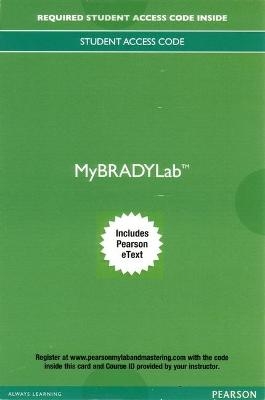
MyLab BRADY with Pearson eText Access Card for Advanced EMT
Pearson (Hersteller)
978-0-13-444273-0 (ISBN)
- Titel z.Zt. nicht lieferbar
- Versandkostenfrei innerhalb Deutschlands
- Auch auf Rechnung
- Verfügbarkeit in der Filiale vor Ort prüfen
- Artikel merken
The 2nd Edition covers the latest treatment guidelines and uses of medication, while enhancing content to support the clinical-reasoning approach. With a chapter-opening Case Study at the start of each chapter, you’ll be guided through real-life EMT emergencies. Then, at the end of each chapter, Case Study Wrap-ups reveal the clinical-reasoning process used by the Advanced EMT to resolve the problems in each case study.
Personalize learning with MyLab Brady with Pearson+ eTextbook This flexible digital platform combines unrivaled content, online assessments and customizable features to personalize learning and improve results.
Pearson+ eTextbook is an easy-to-use digital textbook available within MyLab® that lets you read, highlight and take notes, all in one place.
NOTE: Before purchasing, check with your instructor to confirm the correct ISBN. Several versions of the MyLab and Mastering® platforms exist for each title, and registrations are not transferable. To register for and use MyLab, you will need either a course ID from your instructor or an invitation link that your instructor will send you directly.
Used books, rentals, and purchases made outside of Pearson If purchasing or renting from companies other than Pearson, the access codes for the MyLab platform may not be included, may be incorrect, or may be previously redeemed. Check with the seller before completing your purchase.
About our authors Melissa Alexander, EdD, Paramedic, became an EMT-A in 1982 and earned a Certificate in Paramedicine from Home Hospital School of Paramedicine in Lafayette, Indiana, in 1984. She has a BA in Community Health Education from Purdue University, an MS in Health Sciences Education from Indiana University and an EdD in Human Resources Development from The George Washington University. Dr. Alexander is the Senior Director of Planning, Assessment, and Evaluation for Medical Student Education for Indiana University School of Medicine. She is actively involved in national-level innovations in medical education, including the American Medical Association (AMA) Accelerating Change in Medical Education (ACE) grant and the American Association of Medical Colleges (AAMC) initiative for creating entrustment-based curricula and assessments to ensure medical students’ readiness to enter residency. Dr. Alexander previously served as the Director of the EMS Academy at the University of New Mexico, as an Assistant Professor of Emergency Medicine at The George Washington University, as an Assistant Professor of Criminal Justice, Fire Science and EMS at Lake Superior State University and as a paramedic at Wishard Ambulance Service in Indianapolis. She has authored and contributed to several EMS texts and educational products. Dr. Alexander’s research interests include assessing and improving clinical-reasoning skills and creating valid assessments of learning. She has three daughters, Lindsay (Chris) Giroux, Brittany Streuker and Eleanor Shook; and five grandsons, Asher, Ethan, Grant, Rhys and Jasper. She enjoys bicycling, spending time with family, organic gardening and hanging out with her dogs, Sabrina and Benito. Richard Belle, BS, NRP, a native of New Orleans, Louisiana, began his EMS career in 1996 after completing EMT-Basic and Paramedic training at Nicholls State University in Thibodaux, Louisiana. Richard has worked throughout south Louisiana as a field paramedic, new employee preceptor, student preceptor and as a flight paramedic. He has been actively involved in EMS education since 1999. Richard served as Education Coordinator for Acadian Ambulance’s southeastern district while he returned to Nicholls State University and earned a Bachelor of Science degree. After four years of teaching EMT Basic and Paramedic courses, he transferred to Lafayette, Louisiana, to serve as Acadian Ambulance’s Continuing Education Coordinator; he was responsible for providing refresher training and continuing education opportunities to medics across Louisiana, Texas and Mississippi. Currently, Richard works in Lafayette, Louisiana, as Continuing Education Manager for Acadian Ambulance and the National EMS Academy. Richard lives in south Louisiana with his wife, Rhonda, and their three children, James, Victoria and Allison.
SECTION 1: PREPARING FOR ADVANCED EMERGENCY MEDICAL TECHNICIAN PRACTICE
Introduction to Advanced Emergency Medical Technician Practice
Emergency Medical Services, Health Care, and Public Health Systems
Workforce Wellness and Personal Safety
Ethical and Medical/Legal Considerations in Advanced EMT Practice
Ambulance Operations and Responding to EMS Calls
Communication and Teamwork
SECTION 2: HUMAN DEVELOPMENT, HEALTH, AND DISEASE
Medical Terminology
Human Body Systems
Life Span Development and Cultural Considerations
Pathophysiology: Selected Impairments of Homeostasis
SECTION 3: PHARMACOLOGY
Principles of Pharmacology
Medication Administration
Medications
SECTION 4: ASSESSMENT AND INITIAL MANAGEMENT
General Approach to Patient Assessment and Clinical Reasoning
Scene Size-Up and Primary Assessment
Airway Management, Ventilation, and Oxygenation
Resuscitation: Managing Shock and Cardiac Arrest
Vital Signs and Monitoring Devices
History Taking, Secondary Assessment, and Reassessment
SECTION 5: MEDICAL EMERGENCIES
Respiratory Disorders
Cardiovascular Disorders
Neurologic Disorders
Endocrine Disorders
Abdominal Pain and Gastrointestinal Disorders
Renal, Genitourinary, and Gynecologic Disorders
Hematologic Disorders
Immunologic Disorders
Infectious Illnesses
Nontraumatic Musculoskeletal and Soft-Tissue Disorders
Disorders of the Eye, Ear, Nose, Throat, and Oral Cavity
Mental Illness and Behavioral Emergencies
Toxicologic Emergencies
SECTION 6: TRAUMA
Trauma Systems and Incident Command
Mechanisms of Injury, Trauma Assessment, and Trauma Triage Criteria
Soft-Tissue Injuries and Burns
Musculoskeletal Injuries
Head, Brain, Face, and Neck Trauma
Thoracic Trauma
Abdominal Trauma
Spine Injuries
Environmental Emergencies
Multisystem Trauma and Trauma Resuscitation
SECTION 7: SPECIAL PATIENT POPULATIONS
Obstetrics and Care of the Newborn
Pediatric Emergencies
Geriatrics
Patients with Special Challenges
SECTION 8: RESCUE AND SPECIAL OPERATIONS
Rescue Operations and Vehicle Extrication
Hazardous Materials
Response to Terrorism and Disasters
APPENDICES
Endotracheal Intubation
Advanced ECG Recognition
Adult Intraosseous Infusion
Additional Emergency Medications
| Erscheint lt. Verlag | 19.10.2018 |
|---|---|
| Sprache | englisch |
| Maße | 216 x 279 mm |
| Gewicht | 14 g |
| Themenwelt | Medizin / Pharmazie ► Medizinische Fachgebiete ► Notfallmedizin |
| ISBN-10 | 0-13-444273-3 / 0134442733 |
| ISBN-13 | 978-0-13-444273-0 / 9780134442730 |
| Zustand | Neuware |
| Informationen gemäß Produktsicherheitsverordnung (GPSR) | |
| Haben Sie eine Frage zum Produkt? |